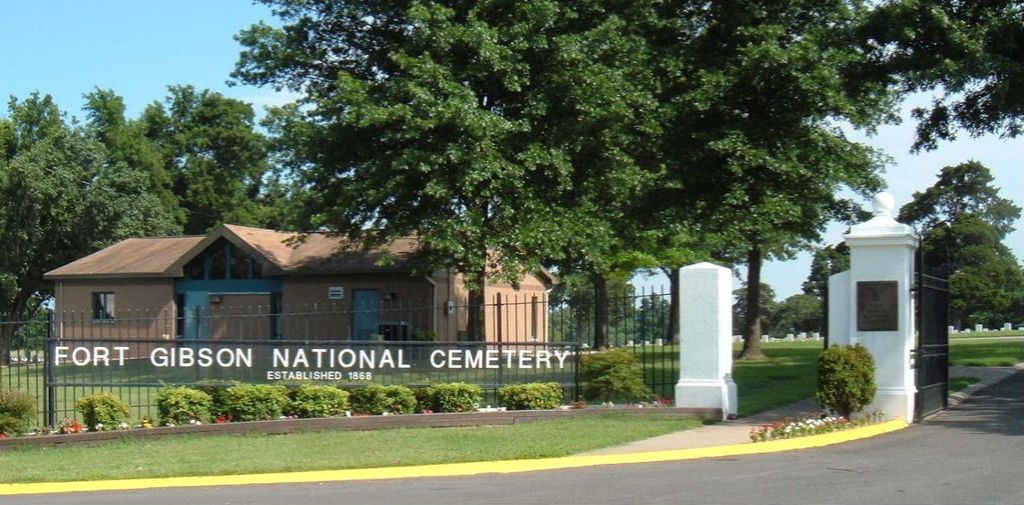
Fort Gibson National Cemetery
Fort Gibson, Muskogee County, Oklahoma, USA
About
-
Get directions 1423 Cemetery Rd
Fort Gibson, Oklahoma 74434 United StatesCoordinates: 35.80470, -95.22890 - 918-478-2334
- Cemetery ID:
Members have Contributed
Advertisement
Photos
Closed federal holidays except Memorial Day and Veterans Day.
Visitation Hours: Open daily from 7:00 a.m. to sunset.
It is situated on land that was once part of the military reservation and is within the limits of the Cherokee Nation. Records indicate the area was probably called Ketona prior to 1824.
From 1863 to 1890, it was garrisoned by many small detachments of troops. In 1891, the War Department turned Fort Gibson over to the Department of the Interior. Although active for only about 60 years, it has been a key post in American military history. Among the many officers stationed at Fort Gibson were Lieutenant Jefferson Davis, General Zachary Taylor and Nathan Boone (son of frontiersman Daniel Boone).
Due to the great tolls exacted by yellow fever, three successive post cemeteries were established at Fort Gibson. Original interments in what is now the national cemetery were mostly the remains of soldiers removed from the abandoned post cemeteries. Other interments are the Union troops who died on the battlefields of the Southwest. In 1868, a plot of seven acres east of Fort Gibson was officially converted into a national cemetery. The soldiers stationed at the fort had previously used the ground for burials, and a few civilians had been interred there prior to 1850. Within the confines of Fort Gibson National Cemetery, there is interred, at least one veteran of every war in which the United States has fought. Graves of known and unknown soldiers lay adjacent to the graves of Native Americans, scouts, civilians, wives and children.
Among the notable burials at Fort Gibson is Talahina Rogers Houston, the second wife of General Sam Houston. Talahina, a Cherokee, married Houston in 1829 after he divorced his first wife. Houston bought a large farm on the Neosho River about two miles northeast of Fort Gibson. Houston, however, soon grew restless and went off to conquer new frontiers, this time in the Southwest where he became president of the Republic of Texas. Talahina died of pneumonia in 1833. According to one story, she died of a broken heart when General Houston left her; another version asserts that he sent messengers back to Talahina asking her to join him by saying that "I have built a kingdom for you." Talahina is said to have replied that he had returned to his people and she would stay with hers.
Closed federal holidays except Memorial Day and Veterans Day.
Visitation Hours: Open daily from 7:00 a.m. to sunset.
It is situated on land that was once part of the military reservation and is within the limits of the Cherokee Nation. Records indicate the area was probably called Ketona prior to 1824.
From 1863 to 1890, it was garrisoned by many small detachments of troops. In 1891, the War Department turned Fort Gibson over to the Department of the Interior. Although active for only about 60 years, it has been a key post in American military history. Among the many officers stationed at Fort Gibson were Lieutenant Jefferson Davis, General Zachary Taylor and Nathan Boone (son of frontiersman Daniel Boone).
Due to the great tolls exacted by yellow fever, three successive post cemeteries were established at Fort Gibson. Original interments in what is now the national cemetery were mostly the remains of soldiers removed from the abandoned post cemeteries. Other interments are the Union troops who died on the battlefields of the Southwest. In 1868, a plot of seven acres east of Fort Gibson was officially converted into a national cemetery. The soldiers stationed at the fort had previously used the ground for burials, and a few civilians had been interred there prior to 1850. Within the confines of Fort Gibson National Cemetery, there is interred, at least one veteran of every war in which the United States has fought. Graves of known and unknown soldiers lay adjacent to the graves of Native Americans, scouts, civilians, wives and children.
Among the notable burials at Fort Gibson is Talahina Rogers Houston, the second wife of General Sam Houston. Talahina, a Cherokee, married Houston in 1829 after he divorced his first wife. Houston bought a large farm on the Neosho River about two miles northeast of Fort Gibson. Houston, however, soon grew restless and went off to conquer new frontiers, this time in the Southwest where he became president of the Republic of Texas. Talahina died of pneumonia in 1833. According to one story, she died of a broken heart when General Houston left her; another version asserts that he sent messengers back to Talahina asking her to join him by saying that "I have built a kingdom for you." Talahina is said to have replied that he had returned to his people and she would stay with hers.
Nearby cemeteries
Fort Gibson, Muskogee County, Oklahoma, USA
- Total memorials3k+
- Percent photographed88%
- Percent with GPS4%
Fort Gibson, Muskogee County, Oklahoma, USA
- Total memorials7
- Percent photographed86%
- Percent with GPS0%
Fort Gibson, Muskogee County, Oklahoma, USA
- Total memorials5
- Percent photographed0%
- Added: 1 Jan 2000
- Find a Grave Cemetery ID: 98460
Success
Uploading...
Waiting...
Failed
This photo was not uploaded because this cemetery already has 20 photos
This photo was not uploaded because you have already uploaded 5 photos to this cemetery
This photo was not uploaded because you have already uploaded 5 photos to this cemetery
Invalid File Type
Birth and death years unknown.
1 photo picked...
2 photos picked...
Uploading 1 Photo
Uploading 2 Photos
1 Photo Uploaded
2 Photos Uploaded
Size exceeded
Too many photos have been uploaded
"Unsupported file type"
• ##count## of 0 memorials with GPS displayed. Double click on map to view more.No cemeteries found






















